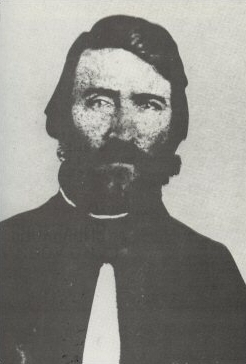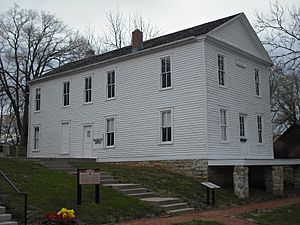Samuel J. Jones facts for kids
Quick facts for kids
Samuel J. Jones
|
|
|---|---|
 |
|
| Postmaster of Westport, Missouri | |
| In office Pre-1855 – February 1, 1856 |
|
| Sheriff of Douglas County, Kansas | |
| In office November 21, 1855 – January 7, 1857 |
|
| Succeeded by | William T. Sherrard |
| Personal details | |
| Born |
Samuel Jefferson Jones
April 16, 1827 Virginia, US |
| Died | December 10, 1883 (aged 56) |
| Spouse | Mary Jones |
Samuel Jefferson Jones (April 16, 1827 – December 10, 1883) was a settler who supported slavery. He served as the sheriff of Douglas County in Kansas Territory from late 1855 to early 1857. He helped create the capital city of Lecompton and was a key figure in the "Bleeding Kansas" conflict. This was a time of violence between those who supported slavery and those who opposed it.
In 1858, he moved to La Mesilla, in what was then New Mexico Territory. He later became a customs collector in El Paso del Norte (now Ciudad Juárez, Mexico). Jones was also involved in a plan to create a new town called Mowry City. When that town did not succeed, he bought a ranch near La Mesilla. He died there in 1883. His tombstone was brought back to Lecompton in 2013.
Contents
Biography of Samuel Jones
Moving to Kansas Territory

Samuel Jones was born in Virginia. Before moving to Kansas, he worked as a postmaster in Westport, Missouri. Around 1854, he moved with his family to the new Kansas Territory. There, he became friends with many settlers who supported slavery.
On March 30, 1855, he helped disrupt elections in Bloomington, Kansas. On August 27, 1855, the acting governor of Kansas Territory, Daniel Woodson, made Jones the first sheriff of Douglas County. Jones went to the capital city of Lecompton. He built a building called Constitution Hall. He then rented this building to the local government that supported slavery.
The Wakarusa War Conflict
On November 21, 1855, a settler who supported slavery, Franklin Coleman, shot and killed Charles Dow. Dow was a "Free Stater," meaning he was against slavery. This happened over a land dispute. Sheriff Jones later arrested Jacob Branson, who was friends with Dow. Branson was rescued by Free Staters. This made the pro-slavery group very angry.
Soon after, the governor of Kansas Territory, Wilson Shannon, asked for the Kansas militia to help. Governor Shannon wanted Kansans to be in the militia. But Jones gathered about 1,500 men, mostly from Missouri, who supported slavery. This group, led by Jones, went to Lawrence. They wanted to remove the Free Staters. The people of Lawrence prepared for a fight. They formed their own group of 800 men.
However, the Missourians never attacked. In December 1855, the governor encouraged both sides to make peace. The Missouri army then left the area.
The Attack on Lawrence
On April 23, 1856, Sheriff Jones went into Lawrence. He tried to arrest members of the Free-State legislature. Jones's presence caused a conflict. Jones was shot but survived. Rumors quickly spread that he had been killed.
After this event, Federal Marshal J. B. Donaldson said that these actions interfered with his duties. A jury then claimed that Lawrence's Free State Hotel was built like a fort. So, Sheriff Jones gathered about 800 southern settlers. He wanted to enforce the pro-slavery laws.
On May 21, Sheriff Jones and his group attacked Lawrence. This event is known as the Sacking of Lawrence. Dr. Robinson’s house was used as a headquarters before it was destroyed. Newspaper printing presses were broken. The Free State Hotel was burned down. The town was also looted.
On January 7, 1857, Jones resigned as sheriff of Douglas County. He said it was because Governor John W. Geary would not give him chains for certain Free-State prisoners. Soon after, he left Kansas Territory completely.
Life in New Mexico Territory
Jones moved to La Mesilla, in New Mexico Territory, in 1858. In September of that year, he was made the collector of customs at Paso del Norte.
In 1859, Jones and two partners, Lewis S. Owings and Robert P. Kelley, owned businesses and mining properties. They wanted more people to move to the area. So, they planned to create a new town. They named it "Mowry City" after a famous person, Sylvester Mowry. They wrote a pamphlet that made Mowry City seem better than it was. It said the town had many minerals and would be the capital of Arizona Territory. At that time, "Arizona" was the name for the southern part of New Mexico Territory.
In 1860, gold was found near Pinos Altos. Mowry City started to grow. But conflicts and the start of the American Civil War made the area unsafe. The settlement then failed.
Around this time, Jones bought a ranch near La Mesilla. In the summer of 1879, he had a stroke. He died sometime after that.
What Happened After His Death
The cemetery in La Mesilla where Jones was buried closed in 1930. His body was moved to another cemetery in Las Cruces, New Mexico. However, his tombstone was left behind in La Mesilla. Over the years, it became damaged.
In 2013, a researcher named Shirley Funk found Jones's tombstone. She arranged for it to be moved to Lecompton. The stone had broken into pieces, so it had to be put back together. The reconstructed tombstone is now near Constitution Hall in Lecompton.

